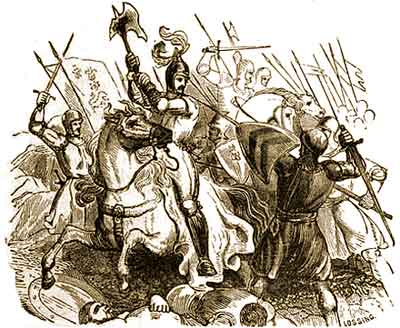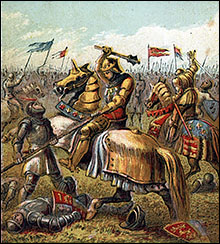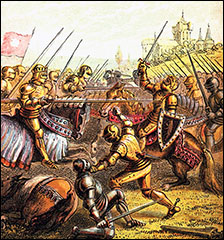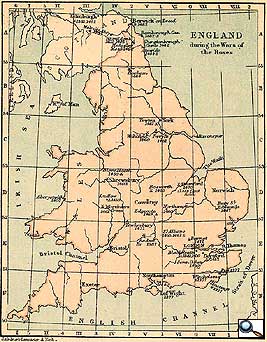
 | House of Lancaster |  | House of York |
WARS OF THE ROSES,1 a name given to a series of civil wars in England during the reigns of Henry VI, Edward IV and Richard III. They were marked by a ferocity and brutality which are practically unknown in the history of English wars before and since.
The honest yeoman of Edward III's time had evolved into a professional soldier of fortune, and had been demoralized by the prolonged and dismal Hundred Years' War, at the close of which many thousands of ruffians, whose occupation had gone, had been let loose in England. At the same time the power of feudalism had become concentrated in the hands of a few great lords, who were wealthy enough and powerful enough to become king-makers. The disbanded mercenaries enlisted indifferently on either side, corrupting the ordinary feudal tenantry with the evil habits of the French wars, and pillaged the countryside, with accompaniments of murder and violence, wherever they went.
It is true that the sympathies of the people at large were to some extent enlisted: London and, generally, the trading towns being Yorkist, the country people, Lancastrian — a division of factions which roughly corresponded to that of the early part of the Great Rebellion, two centuries later, and similarly in a measure indicative of the opposition of hereditary loyalty and desire for sound and effective government. But there was this difference, that in the 15th century the feeling of loyalty was to a great extent focused upon the great lords. Each lord could depend on his own tenantry, and he could, further, pay large bands of retainers. Hence, much as the citizen desired a settlement, the issue was in the hands of the magnates; and as accessions to and defections from one party and the other constantly shifted the balance of power, the war dragged on, becoming more and more brutal with every campaign.
 The first campaign, or rather episode, of these wars began with an armed demand of the Yorkist lords for the dismissal of the Lancastrian element in the King's Council, Henry VI himself being incapable of governing. The Lancastrians, and the king with them, marched out of London to meet them, and the two small armies (3000 Yorkists, 2000 Lancastrians) met at St Albans (May 22, 1455). The encounter ended with the dispersion of the weaker force, and the king fell into the hands of the Yorkists. Four years passed before the next important battle,Blore Heath, was fought (Sept. 23, 1459). In this theEarl of Salisbury trapped a Lancastrian army in unfavourable ground near Market Drayton, and destroyed it; but new political combinations rendered the Yorkist victory useless and sent the leaders of the party into exile.
The first campaign, or rather episode, of these wars began with an armed demand of the Yorkist lords for the dismissal of the Lancastrian element in the King's Council, Henry VI himself being incapable of governing. The Lancastrians, and the king with them, marched out of London to meet them, and the two small armies (3000 Yorkists, 2000 Lancastrians) met at St Albans (May 22, 1455). The encounter ended with the dispersion of the weaker force, and the king fell into the hands of the Yorkists. Four years passed before the next important battle,Blore Heath, was fought (Sept. 23, 1459). In this theEarl of Salisbury trapped a Lancastrian army in unfavourable ground near Market Drayton, and destroyed it; but new political combinations rendered the Yorkist victory useless and sent the leaders of the party into exile.
They made a fresh attempt in 1460, and, thanks partly to treason in the Lancastrian camp, partly to the generalship of Warwick, won an important success and for the second time seized the King [Henry VI] at Northampton (July 10, 1460). Shortly afterwards, after a period of negotiation and threats, there was a fresh conflict. Richard Duke of York went north to fight the hostile army which gathered at York and consisted of Lancashire and Midland Royalists, while his son Edward, Earl of March [later Edward IV], went into the west. The father was ambushed and killed at Wakefield (Dec. 30, 1460), and the Lancastrians, inspired as always by Queen Margaret of Anjou, moved south on London, defeated Warwick at St Albans (Feb. 17, 1461), and regained possession of the King's person.
But the young Earl of March, now Duke of York [later Edward IV], having raised an army in the west, defeated the Earl of Pembroke (Feb. 2, 1461) at Mortimer's Cross (5 mi. W. of Leominster). This was the first battle of the war which was characterized by the massacre of the common folk and beheading of the captive gentlemen — invariable accompaniments of Edward's victories, and conspicuously absent in Warwick's. Edward then pressed on, joined Warwick, and entered London, the army of Margaret retreating before them. The excesses of the northern Lancastrians in their advance produced bitter fruit on the retreat, for men flocked to Edward's standard.
Marching north in pursuit, the Yorkists brought their enemy to bay at Towton, 3 mi. S. of Tadcaster, and utterly destroyed them (March 29, 1461). For three years after Towton the war consisted merely of desultory local struggles of small bodies of Lancastrians against the inevitable. The Duke of York had become King Edward IV, and had established himself firmly. But in 1464, in the far north of England, the Red Rose [House of Lancaster] was again in the field. Edward acted with his usual decision. His lieutenant Montagu (Warwick's brother) defeated and slew Sir Ralph Percy at Hedgeley Moor, near Wooler (April 25, 1464), and immediately afterwards destroyed another Lancastrian army, with which were both Henry VI and Queen Margaret, at Hexham (May 8, 1464). The massacres and executions which followed effectively crushed the revolt.
For some years thereafter Edward reigned peacefully, but Warwick the king-maker and all the Neville following having turned against him (1470), he was driven into exile. But at a favourable moment he sailed from Flushing with 1500 retainers and Burgundian mercenaries, and eluding the Lancastrian fleet and the coast defence troops, landed at Ravenspur (Spurn Head) in Yorkshire in March 1471. His force was hardly more than a bodyguard; the gates of the towns were shut against him, and the country people fled. But by his personal charm, diplomacy, fair promises and an oath of allegiance to King Henry VI, sworn solemnly at York, he disarmed hostility and, eluding Montagu's army, reached his own estates in the Wakefield district, where many of his old retainers joined him.
As he advanced south, a few Yorkist nobles with their following rallied to him, but it was far more the disunion of the Warwick and the real Lancastrian parties than his own strength which enabled him to meet Warwick's forces in a pitched battle. At Barnet, on Easter Eve, April 14, 1471, the decisive engagement was fought. But in the midst of the battle reinforcements coming up under the Earl of Oxford to join Warwick came into conflict with their own party, the badge of the Vere star being mistaken for Edward's Rose-en-soleil. From that point all the mutually distrustful elements of Warwick's army fell apart, and Warwick himself, with his brother Montagu, was slain.
For the last time the unhappy Henry VI fell into the hands of his enemies. He was relegated to the Tower, and Edward, disbanding his army, reoccupied the throne. But Margaret of Anjou, his untiring opponent, who had been in France while her cause and Warwick's was being lost, had landed in the west shortly after Barnet, and Edward had to take the field at once. Assembling a fresh army at Windsor, whence he could march to interpose between Margaret and her north Welsh allies, or directly bar her road to London, he marched into the west on the 24th of April. On the 29th he was at Cirencester, Margaret, engaged chiefly in recruiting an army, near Bath. Edward hurried on, but Margaret eluded him and marched for Gloucester. At that place the governor refused the Lancastrians admittance, and seeking to cross the Severn out of reach of the Yorkists, they pushed on by forced marches to Tewkesbury. But Edward too knew how to march, and caught them up. The battle of Tewkesbury (May 4, 1471) ended with the destruction of Margaret's force, the captivity of Margaret, the death of her son Edward (who, it is sometimes said, was stabbed by Edward IV himself after the battle) and the execution of sixteen of the principal Lancastrians.
or directly bar her road to London, he marched into the west on the 24th of April. On the 29th he was at Cirencester, Margaret, engaged chiefly in recruiting an army, near Bath. Edward hurried on, but Margaret eluded him and marched for Gloucester. At that place the governor refused the Lancastrians admittance, and seeking to cross the Severn out of reach of the Yorkists, they pushed on by forced marches to Tewkesbury. But Edward too knew how to march, and caught them up. The battle of Tewkesbury (May 4, 1471) ended with the destruction of Margaret's force, the captivity of Margaret, the death of her son Edward (who, it is sometimes said, was stabbed by Edward IV himself after the battle) and the execution of sixteen of the principal Lancastrians.
This was Edward's last battle. The rest of his eventful reign was similar in many ways to that of his contemporary Louis XI, being devoted to the consolidation of his power, by fair means and foul, at the expense of the great feudatories. But the Wars of the Roses were not yet at an end. For fourteen years, except for local outbreaks, the land had peace, and then Richard III's crown, struck from his head on Bosworth Field (Aug. 22, 1485), was presented to Henry Earl of Richmond, who, as Henry VII, established the kingship on a secure foundation. A last feeble attempt to renew the war, made by an army gathered to uphold the pretender Lambert Simnel, was crushed by Henry VII at Stoke Field (4 mi S.W. of Newark) on the 16th of June 1487.
1 The name, as is well known, comes from the "white rose of York" and the "red rose of Lancaster"; but these badges, though more or less recognized as party distinctions, by no means superseded the private devices of the various great lords, such as the "falcon and fetterlock" of Richard Duke of York, the "rose in sun" of Edward IV, the "crowned swan" of Margaret, the Vere star, and even the revived "white hart" of Richard II.
The honest yeoman of Edward III's time had evolved into a professional soldier of fortune, and had been demoralized by the prolonged and dismal Hundred Years' War, at the close of which many thousands of ruffians, whose occupation had gone, had been let loose in England. At the same time the power of feudalism had become concentrated in the hands of a few great lords, who were wealthy enough and powerful enough to become king-makers. The disbanded mercenaries enlisted indifferently on either side, corrupting the ordinary feudal tenantry with the evil habits of the French wars, and pillaged the countryside, with accompaniments of murder and violence, wherever they went.
It is true that the sympathies of the people at large were to some extent enlisted: London and, generally, the trading towns being Yorkist, the country people, Lancastrian — a division of factions which roughly corresponded to that of the early part of the Great Rebellion, two centuries later, and similarly in a measure indicative of the opposition of hereditary loyalty and desire for sound and effective government. But there was this difference, that in the 15th century the feeling of loyalty was to a great extent focused upon the great lords. Each lord could depend on his own tenantry, and he could, further, pay large bands of retainers. Hence, much as the citizen desired a settlement, the issue was in the hands of the magnates; and as accessions to and defections from one party and the other constantly shifted the balance of power, the war dragged on, becoming more and more brutal with every campaign.
 The first campaign, or rather episode, of these wars began with an armed demand of the Yorkist lords for the dismissal of the Lancastrian element in the King's Council, Henry VI himself being incapable of governing. The Lancastrians, and the king with them, marched out of London to meet them, and the two small armies (3000 Yorkists, 2000 Lancastrians) met at St Albans (May 22, 1455). The encounter ended with the dispersion of the weaker force, and the king fell into the hands of the Yorkists. Four years passed before the next important battle,Blore Heath, was fought (Sept. 23, 1459). In this theEarl of Salisbury trapped a Lancastrian army in unfavourable ground near Market Drayton, and destroyed it; but new political combinations rendered the Yorkist victory useless and sent the leaders of the party into exile.
The first campaign, or rather episode, of these wars began with an armed demand of the Yorkist lords for the dismissal of the Lancastrian element in the King's Council, Henry VI himself being incapable of governing. The Lancastrians, and the king with them, marched out of London to meet them, and the two small armies (3000 Yorkists, 2000 Lancastrians) met at St Albans (May 22, 1455). The encounter ended with the dispersion of the weaker force, and the king fell into the hands of the Yorkists. Four years passed before the next important battle,Blore Heath, was fought (Sept. 23, 1459). In this theEarl of Salisbury trapped a Lancastrian army in unfavourable ground near Market Drayton, and destroyed it; but new political combinations rendered the Yorkist victory useless and sent the leaders of the party into exile.They made a fresh attempt in 1460, and, thanks partly to treason in the Lancastrian camp, partly to the generalship of Warwick, won an important success and for the second time seized the King [Henry VI] at Northampton (July 10, 1460). Shortly afterwards, after a period of negotiation and threats, there was a fresh conflict. Richard Duke of York went north to fight the hostile army which gathered at York and consisted of Lancashire and Midland Royalists, while his son Edward, Earl of March [later Edward IV], went into the west. The father was ambushed and killed at Wakefield (Dec. 30, 1460), and the Lancastrians, inspired as always by Queen Margaret of Anjou, moved south on London, defeated Warwick at St Albans (Feb. 17, 1461), and regained possession of the King's person.
But the young Earl of March, now Duke of York [later Edward IV], having raised an army in the west, defeated the Earl of Pembroke (Feb. 2, 1461) at Mortimer's Cross (5 mi. W. of Leominster). This was the first battle of the war which was characterized by the massacre of the common folk and beheading of the captive gentlemen — invariable accompaniments of Edward's victories, and conspicuously absent in Warwick's. Edward then pressed on, joined Warwick, and entered London, the army of Margaret retreating before them. The excesses of the northern Lancastrians in their advance produced bitter fruit on the retreat, for men flocked to Edward's standard.
Marching north in pursuit, the Yorkists brought their enemy to bay at Towton, 3 mi. S. of Tadcaster, and utterly destroyed them (March 29, 1461). For three years after Towton the war consisted merely of desultory local struggles of small bodies of Lancastrians against the inevitable. The Duke of York had become King Edward IV, and had established himself firmly. But in 1464, in the far north of England, the Red Rose [House of Lancaster] was again in the field. Edward acted with his usual decision. His lieutenant Montagu (Warwick's brother) defeated and slew Sir Ralph Percy at Hedgeley Moor, near Wooler (April 25, 1464), and immediately afterwards destroyed another Lancastrian army, with which were both Henry VI and Queen Margaret, at Hexham (May 8, 1464). The massacres and executions which followed effectively crushed the revolt.
For some years thereafter Edward reigned peacefully, but Warwick the king-maker and all the Neville following having turned against him (1470), he was driven into exile. But at a favourable moment he sailed from Flushing with 1500 retainers and Burgundian mercenaries, and eluding the Lancastrian fleet and the coast defence troops, landed at Ravenspur (Spurn Head) in Yorkshire in March 1471. His force was hardly more than a bodyguard; the gates of the towns were shut against him, and the country people fled. But by his personal charm, diplomacy, fair promises and an oath of allegiance to King Henry VI, sworn solemnly at York, he disarmed hostility and, eluding Montagu's army, reached his own estates in the Wakefield district, where many of his old retainers joined him.
As he advanced south, a few Yorkist nobles with their following rallied to him, but it was far more the disunion of the Warwick and the real Lancastrian parties than his own strength which enabled him to meet Warwick's forces in a pitched battle. At Barnet, on Easter Eve, April 14, 1471, the decisive engagement was fought. But in the midst of the battle reinforcements coming up under the Earl of Oxford to join Warwick came into conflict with their own party, the badge of the Vere star being mistaken for Edward's Rose-en-soleil. From that point all the mutually distrustful elements of Warwick's army fell apart, and Warwick himself, with his brother Montagu, was slain.
For the last time the unhappy Henry VI fell into the hands of his enemies. He was relegated to the Tower, and Edward, disbanding his army, reoccupied the throne. But Margaret of Anjou, his untiring opponent, who had been in France while her cause and Warwick's was being lost, had landed in the west shortly after Barnet, and Edward had to take the field at once. Assembling a fresh army at Windsor, whence he could march to interpose between Margaret and her north Welsh allies,
 or directly bar her road to London, he marched into the west on the 24th of April. On the 29th he was at Cirencester, Margaret, engaged chiefly in recruiting an army, near Bath. Edward hurried on, but Margaret eluded him and marched for Gloucester. At that place the governor refused the Lancastrians admittance, and seeking to cross the Severn out of reach of the Yorkists, they pushed on by forced marches to Tewkesbury. But Edward too knew how to march, and caught them up. The battle of Tewkesbury (May 4, 1471) ended with the destruction of Margaret's force, the captivity of Margaret, the death of her son Edward (who, it is sometimes said, was stabbed by Edward IV himself after the battle) and the execution of sixteen of the principal Lancastrians.
or directly bar her road to London, he marched into the west on the 24th of April. On the 29th he was at Cirencester, Margaret, engaged chiefly in recruiting an army, near Bath. Edward hurried on, but Margaret eluded him and marched for Gloucester. At that place the governor refused the Lancastrians admittance, and seeking to cross the Severn out of reach of the Yorkists, they pushed on by forced marches to Tewkesbury. But Edward too knew how to march, and caught them up. The battle of Tewkesbury (May 4, 1471) ended with the destruction of Margaret's force, the captivity of Margaret, the death of her son Edward (who, it is sometimes said, was stabbed by Edward IV himself after the battle) and the execution of sixteen of the principal Lancastrians.This was Edward's last battle. The rest of his eventful reign was similar in many ways to that of his contemporary Louis XI, being devoted to the consolidation of his power, by fair means and foul, at the expense of the great feudatories. But the Wars of the Roses were not yet at an end. For fourteen years, except for local outbreaks, the land had peace, and then Richard III's crown, struck from his head on Bosworth Field (Aug. 22, 1485), was presented to Henry Earl of Richmond, who, as Henry VII, established the kingship on a secure foundation. A last feeble attempt to renew the war, made by an army gathered to uphold the pretender Lambert Simnel, was crushed by Henry VII at Stoke Field (4 mi S.W. of Newark) on the 16th of June 1487.
1 The name, as is well known, comes from the "white rose of York" and the "red rose of Lancaster"; but these badges, though more or less recognized as party distinctions, by no means superseded the private devices of the various great lords, such as the "falcon and fetterlock" of Richard Duke of York, the "rose in sun" of Edward IV, the "crowned swan" of Margaret, the Vere star, and even the revived "white hart" of Richard II.
Text source:
Encyclopedia Britannica, 11th Ed. Vol XXIII.
Cambridge: Cambridge University Press, 1910. 736-.


May 22, 1455 First Battle of St Albans  Sep 23, 1459 Battle of Blore Heath  Oct 12, 1459 Rout at Ludford Bridge  Jul 10, 1460 Battle of Northampton  Dec 30, 1460 Battle of Wakefield  Feb 2, 1461 Battle of Mortimer's Cross  Feb 22, 1461 Second Battle of St Albans  Mar 28, 1461 Skirmish at Ferrybridge  Mar 29, 1461 Battle of Towton  Apr 25, 1464 Battle of Hedgeley Moor  May 15, 1464 Battle of Hexham  Jul 26, 1469 Battle of Edgecote  Mar 12, 1470 Battle of Loosecoat Field  Apr 14, 1471 Battle of Barnet  May 4, 1471 Battle of Tewkesbury  Aug 22, 1485 Battle of Bosworth  Jun 16, 1487 Battle of Stoke Field  |
Map source:
Colbeck, Charles. The Public Schools Historical Atlas.
New York: Longmans, Green, & Co., 1905.
No comments:
Post a Comment